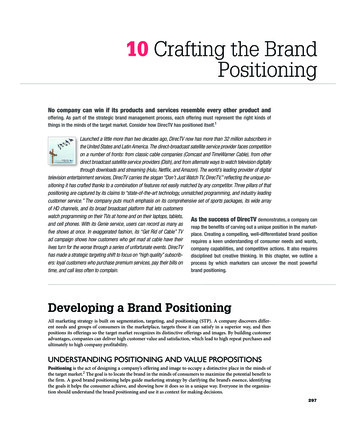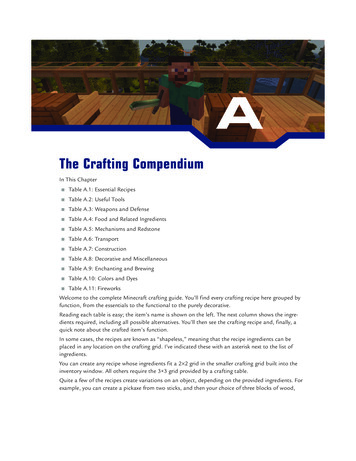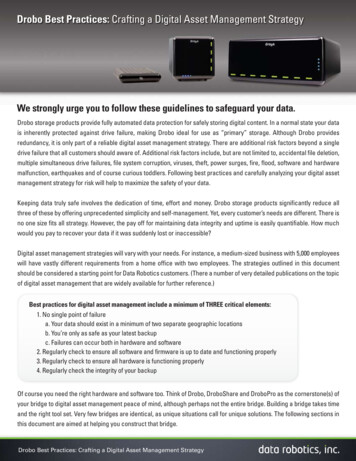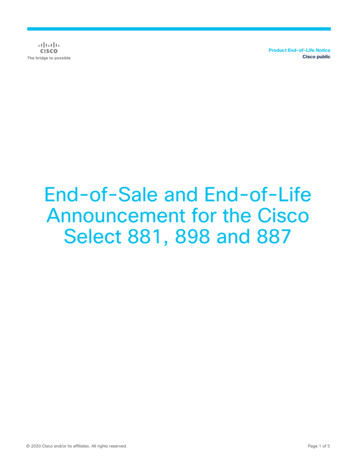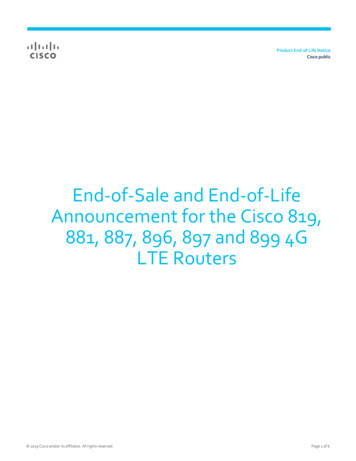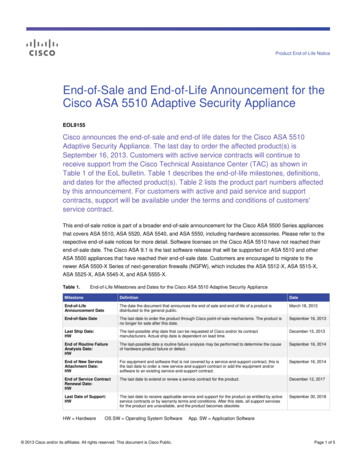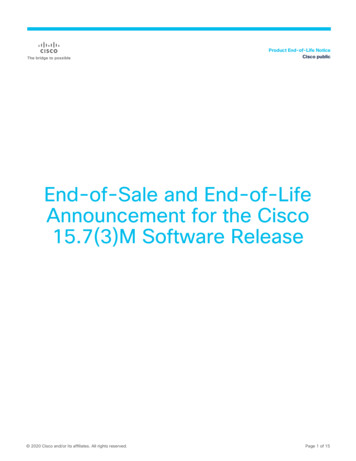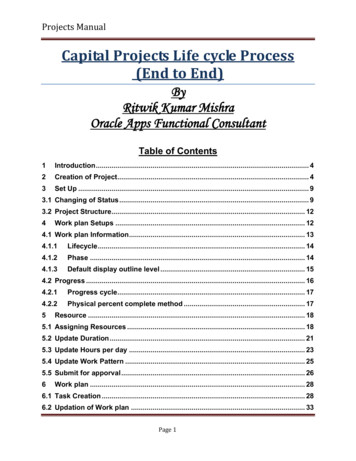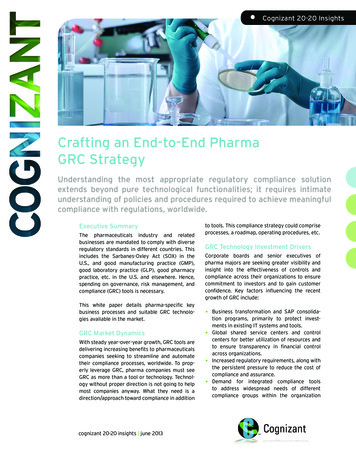
Transcription
Cognizant 20-20 InsightsCrafting an End-to-End PharmaGRC StrategyUnderstanding the most appropriate regulatory compliance solutionextends beyond pure technological functionalities; it requires intimateunderstanding of policies and procedures required to achieve meaningfulcompliance with regulations, worldwide.Executive SummaryThe pharmaceuticals industry and relatedbusinesses are mandated to comply with diverseregulatory standards in different countries. Thisincludes the Sarbanes-Oxley Act (SOX) in theU.S., and good manufacturing practice (GMP),good laboratory practice (GLP), good pharmacypractice, etc. in the U.S. and elsewhere. Hence,spending on governance, risk management, andcompliance (GRC) tools is necessary.to tools. This compliance strategy could compriseprocesses, a roadmap, operating procedures, etc.GRC Technology Investment DriversCorporate boards and senior executives ofpharma majors are seeking greater visibility andinsight into the effectiveness of controls andcompliance across their organizations to ensurecommitment to investors and to gain customerconfidence. Key factors influencing the recentgrowth of GRC include:This white paper details pharma-specific keybusiness processes and suitable GRC technologies available in the market. GRC Market Dynamics With steady year-over-year growth, GRC tools aredelivering increasing benefits to pharmaceuticalscompanies seeking to streamline and automatetheir compliance processes, worldwide. To properly leverage GRC, pharma companies must seeGRC as more than a tool or technology. Technology without proper direction is not going to helpmost companies anyway. What they need is adirection/approach toward compliance in additioncognizant 20-20 insights june 2013 Business transformation and SAP consolidation programs, primarily to protect investments in existing IT systems and tools.Global shared service centers and controlcenters for better utilization of resources andto ensure transparency in financial controlacross organizations.Increased regulatory requirements, along withthe persistent pressure to reduce the cost ofcompliance and assurance.Demand for integrated compliance toolsto address widespread needs of differentcompliance groups within the organization
and to consolidate disparate indicators andstandards for judging compliance across theorganization.Pharma companies are under enormouspressure since they need to assure clinicaltrials and drug manufacturing quality standards to consumers/government, in additionto finance-related assurance to stakeholders.Pharma businesses expect – and are ready – toinvest in GRC solutions that address all of theirrequirements. This eventually created a waveof innovation among GRC vendors.GRC Technology OverviewToday’s compliance departments need an integrated solution to address various stakeholderrequirements. Figure 1 highlights the differentmodules. What follows is a detailed assessment ofthe specific functionalities required.Enterprise risk management: Perform business risk assessments.Prioritize risks and prepare mitigation plans.Actively monitor changes in risk profile.Report incidents.Policies and control repository: Map policy requirements to processes,risks and controls.Maintain a repository of test scripts/data.Automatically report on results.Track exception and remediation plans.Security and segregation of duties: Facilitate automated testing of system accesscontrols.Facilitate automated testing of segregationof duties.Audit lifecycle management: Document independent audit activities.Provide quality assurance over complianceactivities.Report results.Track exceptions and remediation activities.Investment in specific modules depends on budgetdecisions from various units. As no single person“owns” four module deployments, there should beproper alignment among different stakeholdersto buy one solution for all of their requirements.Hence, selection of a GRC vendor is a processthat should be orchestrated carefully to avoidredundant solutions and to achieve cost savings.(See GRC Tools and Vendor Consideration Processfurther down on how to make this happen.)All of the above mentioned regulations/framework can be centrally configured in GRC, as shownin Figure 2, next page.GRC Technology Vendor OverviewGRC vendors can be classified into three maincategories: GRC integrated with ERP solutions: SAP andOracle are the only integrated GRC solutionsavailable. SAP’s GRC 10 is tightly integratedComponents of GRCEnterpriseRiskManagementAuditGRC CentralLifecycleManagement RepositorySecurity andSegregationof DutiesFigure 1cognizant 20-20 insights2Policies andControlRepository
with SAP’s ERP solutions in terms of designand architecture, which ensures more automated operations at a reduced cost and strongsystems performance.GRC-focused solutions: These solutions lackERP integration and process automation.Hence, their performance and automationpales in comparison with GRC solutions integrated with ERP.GRC niche solutions: This category includesproven solutions from companies such asApprova. For example, Approva’s Bizrights isa leading product in the European market andis positioned as a hybrid solution betweenintegrated and GRC-focused offerings in termsof benefits.What follows is a discussion of vendorconsiderations and an assessment of SAP GRCand Approva One (the latest version of ApprovaBizrights), two solutions with which we have vastexperience implementing for numerous pharmacompanies.GRC Tools and Vendor ConsiderationProcessFigure 3, next page, depicts a typical pharmacompany’s organizational hierarchy.There are many questions to help understandyour organization’s GRC needs. We list some ofthe more important ones below:What is the value proposition you anticipatefrom GRC? Do you need a single source risk and controlsolution? It is nothing but a centralized repository ofrisks and controls across all regulations.Solution benefits: Easy communication to audit stakeholders.Reliable change control.Automated updates to control set.Systematic allocation of ownership andaccountability.Cross-Functional GRC CapabilityGlobal Compliance PlatformGRC Technology1. Maintenance of central masterdata structures: Multiple compliance frameworks. Business objectives. Organizational hierarchy. Risk and response catalog. Account groups and financialassertions. Policies and procedures(lifecycle management). Entity level controls catalog. Process and controls repository. Control objectives catalog.2. Maintenance of “central”evaluation templates: Assessment plans (survey library). Manual test plans. Automated test scripts.Compliance Framework – COBITCompliance Framework – UK Bribery ActCompliance Framework SoX1. Assignment of relevant centralmaster data (ability to allow orprevent local modifications).2. Assignment of relevant controlevaluation templates (standardizationof testing/assessment procedures).3. Compliance-specific reportingplatform and evidence repository.4. Ability to allow or prevent “sharedevaluations” with other complianceframework(s).3. Cross-compliance planning andreporting platform: Centralized planning andmonitoring of ongoingcompliance activities. Holistic view of complianceactivities across multipleframeworks.5. Compliance-specific roles andauthorization model.Figure 2cognizant 20-20 insightsCompliance Framework – Contract3
Formalization of control framework.Reduced controls.Do you need a tool to address cross-functionalcontrol and compliance framework requirements?Your organization might require a tool tomanage diversified compliance requirementssuch as financial control framework (FCF), IScontrol framework and SOX control frameworkunder one single roof.Solution benefits: Solution benefits: Reduced rework and duplication of compliancedata.Effective utilization of controls: Linkage of keycontrols to multiple regulation risks.Linkage to organization policies andprocedures.Would you like to automate the controlself-assessment cycle?This means you can enter control validationprocedures and results within GRC. The entirelifecycle of self-assessment, from self-assuranceto control effectiveness reporting, would then beautomated with the help of GRC.Solution benefits: Does your organization desire sophisticatedreporting and remediation trend analysis?This is necessary for organizations that are nothappy with the reporting features of their currentcompliance tool. GRC provides much improvedreporting on violations and helps predictremediation trends.Effective risk assessment and scoping.Roll-forward capability.Automatic communication.Status reporting and escalation management.Reduced reliance on off-line progress.Flexible visibility of control operation andremediation progress.Targeted remediation effort.Has your organization had to confront concerns voiced by the business that it is beingover-audited?This means that synergy and alignment is requiredamong different compliance-relevant proceduresperformed by multiple lines of defense.Solution benefits: Efficient effort and reduced duplication.Does your organization require the completeinsight of continuous monitoring: data, controland transactions?This question concerns whether the businessneeds thorough monitoring on transactionsbeing done through the ERP systems againstpre-configured rules. For example, monitoring tobe done on the purchase module will yield thefollowing insights: Who performed more purchases?Was it appropriately approved?Were purchases realized into inventories?Pharma Industry Organizatonal HierarchyPharma PLCCommercialR&DFinanceOperationsand ISGlobalComplianceRegionalAudit GroupGroupInternal AuditFigure 3cognizant 20-20 insights4
Solution benefits: frame, the reasons they occur and a possiblemeans for mitigating this issue.Automated testing of controls is performedby GRC.Continuous monitoring of GRC offers “detective” controls. Detective controls are the ruleset/processes in place that detect violationsonly after the control breach. For example, ifthe organization decides that purchase requisitions worth more than 10,000 require threelevels of approval, then any purchase worthmore than 10,000 yet containing only twolevels of approval will be flagged as a violation.This feature helps organizations discover howmany violations occur within a particular timeIs your organization looking for integratedsecurity and SOD along with GRC?This means that automated user provisioningto ERP is required after segregation of dutiesanalysis from GRC.Solution benefits: Reduce SOD analysis effort.Automated user provisioning reduces effortfrom the security team and it improves reliance on complex SOD compliance.Comparing Approva One vs. SAP GRCApprova One seamlessly supports ERP products such asSAP, Oracle, PeopleSoft and CGI.It has rule templates ready forthe same. Any other third-partyCRM systems and HR systemscan also be included withinApprova One with additionalcustom configuration effort.SAP GRC 10 seamlessly supports only SAP products. Though there areprovisions given like non-SAP adapters for GRC or integration throughIDM, etc. these are not proven.Approva One comes with twomodules: Authorization Insightand Process Insight.SAP GRC 10 comes with modules for access control and process control,but as an integrated solution (in contrast with predecessor releases) alsohas a risk management module.Authorization Insight:Responsible for rule bookdesign, exception management,mitigation controls, continuousmonitoring and risk analysis.Access Control:Access control simplifies the remediation and mitigation process withthe help of process control components. It allows central managementof firefighter IDs, streamlines the temporary super-user access log reviewby adding workflow capabilities and has business role concepts.Process Insight:Responsible for audit lifecyclemanagement like SOX framework design, design effectiveness review, internal auditplanning and testing ofcontrols, etc.Process Control:This helps to define and set up automated monitoring of controls andworkflow alerts including transactional record and configuration changes atSAP ERP. SAP Business Objects GRC 10 version provides capabilities aroundcontent lifecycle management that allows the import and export of risksand controls together by enhancing the integration with AC and PC intoa single enterprise risk management platform that provides summarizedviews representing the different organizational risks and related automated,manual and security controls from a business process perspective.Risk Management:SAP GRC 10 has a separate module called risk management, in contrastto Approva. This deals with risk assessment and risk prioritization. SAPrisk management enables an enterprise-wide risk management process asmandated by certain legal requirements and recommended by best-practicemanagement frameworks. SAP risk management uses the various work centers of the GRC, in which you can carry out all risk management activities.The process control component of GRC 10 complements risk management.SAP bifurcated the risk management aspect of GRC into a separate moduleto give better visibility to executive management who actually require abird’s eye view of enterprise risks and its mitigation controls.Figure 4cognizant 20-20 insights5
Other questions to resolve include: Do you know the ratings/pros and cons ofvarious compliance tools in the market?» Before you start researching GRC solutions,ensure that you read recent analysis fromForrester and Gartner – the two top marketresearch companies. What needs to be considered before constituting the program to identify a suitableGRC vendor?» Key users of compliance are in finance. Butbe sure to include other key stakeholders/representatives in the GRC program, according to their weight in compliance needs.» Primarily target your organization’s ERPenvironment. But be sure to include alltools that fall within the compliance ring.» Elicitneedsfordifferen
SAP GRC 10 has a separate module called risk management, in contrast to Approva. This deals with risk assessment and risk prioritization. SAP risk management enables an enterprise-wide risk management process as mandated by certain legal requirements and recommended by best-practice management frameworks. SAP risk management uses the various work cen- ters of the GRC, in which you can File Size: 1MBPage Count: 7

